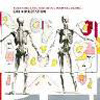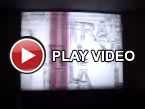Peter Hope & The Jonathan S. Podmore Method, "Dry Hip Rotation'
 The methods used by Jonathan S. Podmore and Peter Hope on Dry Hip Rotation were quite oblique as far as strategies go. Storming the studio with little more than a few scrounged AKS synths, a violin, harmonica, and whatever else happened to be lying around they managed to smash together their art punk masterpiece in a mere six days, presumably so they could rest on the seventh. The majority of the music produced on the album does not even come from sources generally thought of as musical instruments. Everything from a Creda 400 tumble drier to toilets and scaffolding pipes are used (Joe Meek would have been proud). The outstanding lyricism and vocal performance of Peter Hope coupled with Jonathan’s tape loops (several meters in length) make for a riveting listen.
The methods used by Jonathan S. Podmore and Peter Hope on Dry Hip Rotation were quite oblique as far as strategies go. Storming the studio with little more than a few scrounged AKS synths, a violin, harmonica, and whatever else happened to be lying around they managed to smash together their art punk masterpiece in a mere six days, presumably so they could rest on the seventh. The majority of the music produced on the album does not even come from sources generally thought of as musical instruments. Everything from a Creda 400 tumble drier to toilets and scaffolding pipes are used (Joe Meek would have been proud). The outstanding lyricism and vocal performance of Peter Hope coupled with Jonathan’s tape loops (several meters in length) make for a riveting listen.
Formerly a vocalist for The Box (members from Clock DVA) Peter Hope circulated in the same Sheffield milieu as did Cabaret Voltaire. In 1985, the same year The Box became defunct, he recorded the 12" Leather Hands with Richard H. Kirk. As fun as that was he was still looking for a sound he could call his own, something totally original. Jonathan S. Podmore showed up right on time, on Saturday the 14th of June 1986 to be exact. Peter had been invited to sing at a show that night. In an introspective mood he sat despondently on the steps of Sheffield City Hall, lamenting the fact that there was no suitable music to accompany his poetic vocals (think of a bard who sings not of the old gods, goddesses and heroes, but of dreary canals, murdered husbands, needles, knives and fatal workplace accidents). Jonathan approached Mr. Hope at this moment with a tape in hand. Somewhat of a stalker (or maybe just rabid fan) he said, "I have secretly followed your career and feel this may be the time for you to consider the music I have composed." The humble cassette was passed to Peter, in a scene reminiscent of two Freemasons shaking hands, only in this case it was not the grip that was secret, but the sounds on the tape. "I shall meet you here again in two hours - if you wish," Jonathan said before disappearing. Two hours later he returned having listened to the sounds that Jonathan S. Podmore had produced with his arcane METHOD. A friendship had been forged, and Peter now had the accompaniment he needed for the evenings performance, a Rock Against Racism gig featuring New Order and Cabaret Voltaire.
A record company had offered Peter a grand to cut an album, which he accepted. What is amazing is that he was left to it without any oversight. I am glad there wasn’t any because it surely would have interfered with the unrestrained creativity that Jonathan and Peter exhibit on Dry Hip Rotation. The limitations imposed on them by a shortfall of equipment pushed them forward creatively as they experimented with what was readily available. The opening "Kitchenette" is barbaric, murderous, and lots of fun. The rattle and clatter of percussive cutlery and baking tins gives the song a propulsive drive. Disturbing sounds, suggestive of a garbage disposals whirling blades cut through the mix, as Peter sings "disposing of the husband while consoling the wife" with redolent charm.
The next song "Canal" begins with a slurch of dirty water. TV voices full of tinny chorus fade in, creating a sense of dread isolation. (A television is on in the background to fill the silence of a flat. News shows are watched for entertainment but the fear they provoke exacerbates the disconnection people already feel between each other.) Meanwhile some others drift down a canal whose banks are made of paved concrete on a raft "lashed together with chicken wire." Multi-tracked vocals allow Peter to sing in the round with himself as the boys "go into the tunnels". Listening to this song I can become an urban explorer and spelunker without any of the nasty bits: rats, rusty nails, foul water. "Dry Bone" is a more sparse arrangement with only a few treatments added to a recitation that starts off slow and proceeds towards the spastic, as Peter hits notes more shrill than usual for his low deep voice.
"Needleheat" is the perfect antidote to the current plethora of advertisements for antidepressants that have become so ubiquitous, as he belts out "pills for ills and ills for pills. Pills to alleviate the drug induced ills caused by those who make these pills". The prepared piano tinkles away in a mode that is as manic as it is minimalist. Other bell-like sounds chime away in a pleasantly unnerving melody. "The Unknown Industrial Fatality" is one of the most memorable songs of the disc. The gregarious saxophones bubbling throughout imprint the piece with a happy go lucky feeling made all the more ironic by a vocal style suitable for infomercials and slick advertising. (Peter Hope could be a good voice over artist.) The sound of whirling blades returns and synthetic metal grinders as he describes the danger an industrial worker could be in if his attention slips from the dangerous processes at hand. Suffice it to say that when the frayed edge of his clothes gets caught in the blade the worker meets his grisly end.
By working their own method this album from 1986 has weathered very well. It was reissued at the tail end of 2009.
samples:
 



